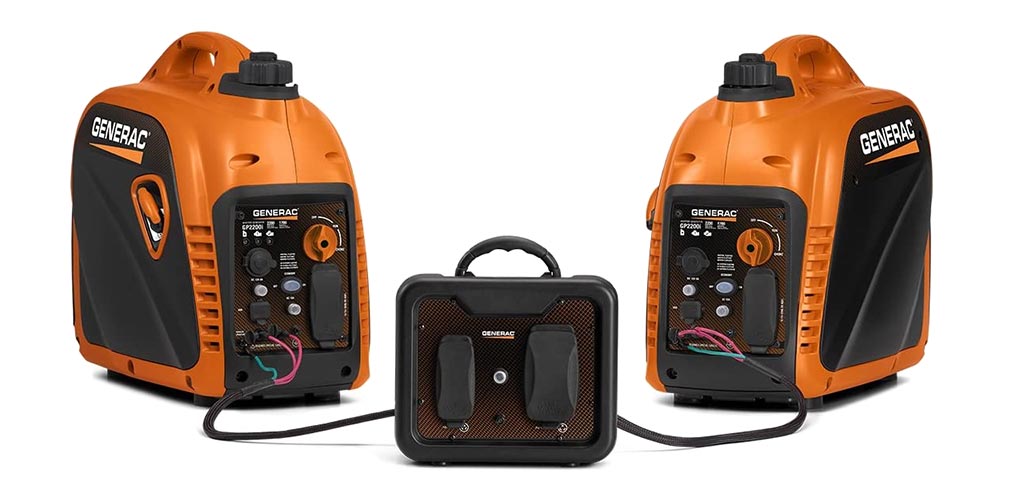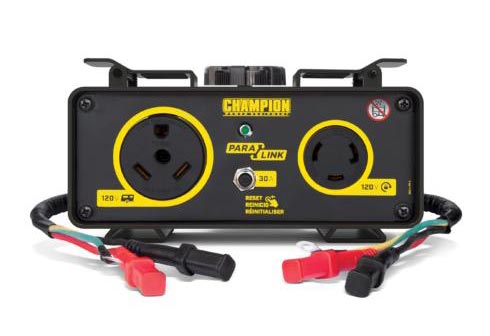There is another way to get more power if you have increased power demands. Instead of buying a completely new, bigger generator, you can try paralleling generators. Although it may sound complicated, generator paralleling is pretty simple with all the instructions and kits available today. However, there are a couple of things you need to know before you set off to buy another portable generator and a paralleling kit.
What is Paralleling Generators?
If you ever wondered if you could “join forces” and connect two generators, you were actually thinking about paralleling generators. The answer is – yes, you can run two or more inverter generators in parallel. What happens then is that you make a connection between generators and run them in tandem. As a result, you increase the power output and do more than just a single generator.
Let’s say you own a 2000 watt generator, but you realize you need more power to run your air conditioner. By adding another portable generator to your system, you will get enough power and amps to run your critical loads and the air conditioner as well.
Is Running Generators in Parallel Better than Buying a Large Generator?
The logical question that follows is why buy multiple generators and run them together when there is a single larger generator that can meet the power demand. But, there are several very good reasons to do this.
- If you already own an inverter generator, it’s more cost-effective and less wasteful to buy another smaller unit than to completely give up the one generator you already have.
- Having an additional generator is a great safety net. Imagine you’re on a wonderful trip with your RV when one of your generators fails. If you had one unit, that would be a problem. But with two, you still have one for your essential needs. You may not be able to power your AC unit until you get more electrical power, but you won’t be left completely without options.
- Running generators in parallel is usually less expensive than buying a larger generator which can ensure enough power for your needs.
- Two smaller units are much more lightweight and portable than one bigger unit.
- Inverter generators are generally much quieter than other portable generator types.
As you can see, there are some serious advantages to running generators in parallel. But depending on your situation, one powerful portable generator may be a better solution for you. If you know you’ll be in constant need of more power, and you won’t need to transport your generator frequently, then you may opt for using a single generator as opposed to two in parallel.
Why Do We Parallel Generators?
The main reason for using generators in parallel is getting more power by connecting multiple generator sets. Some other reasons are reducing cost and redundancy. Having a backup generator for powering essential appliances and having more portable units rather than a large, heavy one.

Things to Know Before You Start
Now that you understand all the benefits of parallel generators and why to do it, let’s talk about everything you need to know before you connect your generators.
Which Generators Can Run in Parallel?
Before you even think about using two generators at the same time, you need to know if they can be used like this. Almost all newer models of inverter generators on the market are ‘parallel capable’. But this is something you need to check in the user manual or with the manufacturer before use. Make a note of the fact that we said “inverter generator”, and it is for a reason.
There are multiple benefits of using inverter generators, one of them being that they can run in parallel. Non-inverter generators can also be connected, but this process is far more complicated. On the other hand, connecting two generators when they are inverter is easy. Inverter generators are also more fuel-efficient, often come with an eco-mode, and are more portable than other generators.
If one of the generators you are using is not parallel capable, there is still a way to connect them. However, this process carries risks, and you can easily damage your generators and cause even more significant problems. Not to mention, this can void your warranty.
Can You Parallel Two Different Brand Generators?
Yes, it usually can be done. However, most manufacturers will recommend using only their brand in parallel because this is usually the safest and most simple way. If you have no knowledge about how electricity works, it may be best to stick to the manufacturer’s recommendations.
Regardless, different brand generators can run in parallel, but you need to make sure of the compatibility. This means that the points of connection have the same voltage and frequency. However, keep in mind that this is true only for inverter generators.
Can You Parallel Two Different Size Generators?
Yes, running two different-sized generators together can be done, but it’s not ideal. Keep in mind that if you decide to do so, the load capacity will match the weaker generator. So if you have a 3000-watt and a 5000-watt generator, you’ll get only 3000 watts. It’s better and more beneficial to get two units with the same power capacity.
That said, some brands offer parallel kits that allow you to connect different generator sizes of the same brand line. These include the PowerSmart series from Briggs and Stratton, the iGen series from Westinghouse, Energizer, Firman, and some WEN models.
Can You Parallel Non-Inverter Generators?
Yes, technically. But it’s a complicated process that requires skill and equipment, none of which guarantees that you’ll get a good outcome. We recommend sticking to an inverter generator or two of them in our case.
Can Paralleling Damage Generators?
If you follow the manufacturers’ instructions, use proper parallel cables or kits, and connect everything correctly, you won’t cause any damage. Paralleling itself is not damaging, as long as the generators in parallel are compatible and connected properly.
Step by Step on How to Parallel Generators

Setting up your generators is not difficult if you have suitable generators and the proper parallel kit. With the right tools, all the skills you need are to read the owner’s manual, and you’re good to go. But let’s go a bit more in detail.
Ensure they are compatible
The first thing to do is check whether the two generators you have can be paralleled and whether they can be connected to one another. Firstly, check the power compatibility, i.e., whether they have the same wattage. Although possible, two different size generators are not the best options. Another thing to check is the frequency, i.e., the alternator.
Both of them should match, or the lower frequency one can damage the entire system. You should also make sure that the interfaces of both models are compatible, which means they can communicate with each other. This is where having the same model and brand is ideal.
When you ensure you can synchronize your generators, meaning all these points are compatible, the load sharing is automatic. There’s no need for monitoring, making the use of a parallel system much less demanding.
Using the paralleling kits
If you went for the straightforward option to parallel generators, which means connecting two generators of the same brand, model, and size, then you’ll also need a parallel kit. This is a port with six terminals, 4 of which are connected to generators, while the other 2 are grounded. A parallel kit allows you to make a connection between the two generators so you can run them together successfully. You can find out which kit works with your generator in the user manual.
All the well-known brands produce their own kits, so they would make the process much easier. Another benefit of getting the parallel kit from your generator brand is that you can be sure that everything is compatible.
Connect the two generators
By reading the owner’s manual and making sure you take note of each port and what goes where, you’ll connect your generators in a couple of minutes.
Bottom Line
Running generators in parallel can provide double power and meet all your power needs, including running larger appliances such as the air conditioner, water heater, and critical power demands. This is a convenient way to get additional power for a lower cost (both when purchasing and later when maintaining your generators). And since you can parallel only inverter generators, you also get quiet operation and better fuel efficiency. Next time your power supply runs short, consider getting another unit.

